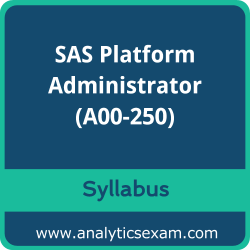 Welcome to your one-stop solution for all the information you need to excel in the SAS Platform Administration for SAS 9 (A00-250) Certification exam. This page provides an in-depth overview of the SAS A00-250 Exam Summary, Syllabus Topics, and Sample Questions, designed to lay the foundation for your exam preparation. We aim to help you achieve your SAS Certified Platform Administrator for SAS 9 certification goals seamlessly. Our detailed syllabus outlines each topic covered in the exam, ensuring you focus on the areas that matter most. With our sample questions and practice exams, you can gauge your readiness and boost your confidence to take on the SAS Platform Administrator exam.
Welcome to your one-stop solution for all the information you need to excel in the SAS Platform Administration for SAS 9 (A00-250) Certification exam. This page provides an in-depth overview of the SAS A00-250 Exam Summary, Syllabus Topics, and Sample Questions, designed to lay the foundation for your exam preparation. We aim to help you achieve your SAS Certified Platform Administrator for SAS 9 certification goals seamlessly. Our detailed syllabus outlines each topic covered in the exam, ensuring you focus on the areas that matter most. With our sample questions and practice exams, you can gauge your readiness and boost your confidence to take on the SAS Platform Administrator exam.
Why SAS Platform Administrator Certification Matters
The SAS A00-250 exam is globally recognized for validating your knowledge and skills. With the SAS Certified Platform Administrator for SAS 9 credential, you stand out in a competitive job market and demonstrate your expertise to make significant contributions within your organization. The SAS Platform Administration for SAS 9 Certification exam will test your proficiency in the various syllabus topics.
SAS A00-250 Exam Summary:
| Exam Name | SAS Platform Administration for SAS 9 |
| Exam Code | A00-250 |
| Exam Duration | 110 minutes |
| Exam Questions | 65 |
| Passing Score | 66% |
| Exam Price | $180 (USD) |
| Books / Training | SAS®9 Administration Fast Track |
| Exam Registration | Pearson VUE |
| Sample Questions | SAS Platform Administration Certification Sample Question |
| Practice Exam | SAS Platform Administration Certification Practice Exam |
SAS A00-250 Exam Syllabus Topics:
| Objective | Details | Weight |
|---|---|---|
| Managing the SAS Environment |
- Secure a SAS platform configuration.
- Update SAS Software
- Work with the SAS Metadata Server.
- Promote metadata and associated content. |
15% |
| Monitoring, Logging, and Troubleshooting SAS Servers |
- Monitor SAS servers.
- Administer SAS server logging and modify logging configurations.
- Troubleshoot basic SAS server issues such as server availability.
- Identify the properties and functionality of SAS servers.
|
15% |
| Backing Up the SAS Environment |
- Backup and restore the SAS environment.
- Backup and restore Metadata.
|
8% |
| Administering Users |
- Manage connection profiles. - Register users and groups in the metadata.
- Determine when to store passwords in the metadata |
22% |
| Administering Data Access |
- Register libraries and tables in the metadata. - Update table metadata. - Pre-assign a library. - Troubleshoot data access problems. - Use the metadata LIBNAME engine. |
20% |
| Managing Metadata Authorization |
- Identify how the metadata authorization layer interacts with other security layers. - Identify where, how, and to whom metadata permissions are assigned. - Determine the outcome of metadata authorization decisions. - Use metadata permissions to secure metadata
- Create and use Access Control Templates. |
20% |
The SAS has created this credential to assess your knowledge and understanding in the specified areas through the A00-250 certification exam. The SAS Certified Platform Administrator for SAS 9 exam holds significant value in the market due to the brand reputation of SAS. We highly recommend thorough study and extensive practice to ensure you pass the SAS Platform Administration for SAS 9 exam with confidence.
